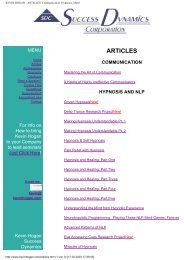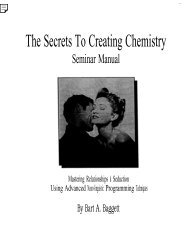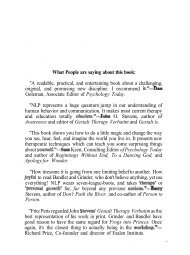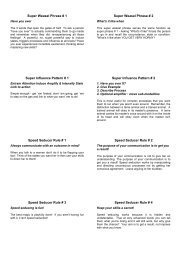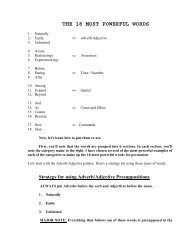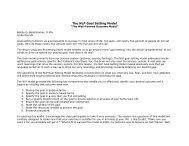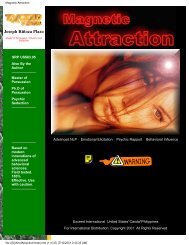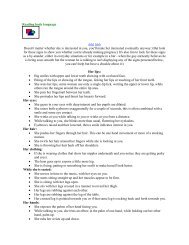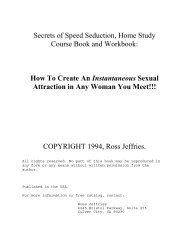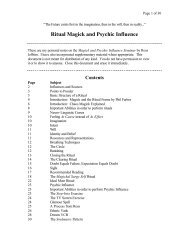A Pragmatic Guide To Communication & Change.pdf - NLP Info Centre
A Pragmatic Guide To Communication & Change.pdf - NLP Info Centre
A Pragmatic Guide To Communication & Change.pdf - NLP Info Centre
- No tags were found...
Create successful ePaper yourself
Turn your PDF publications into a flip-book with our unique Google optimized e-Paper software.
the Meta Model: a linguistic tool for using portions of . person's spoken or written<br />
behavior to determine where he has generalized, deleted, or distorted experiences in his<br />
model of the world. It includes specific "Meta Model responses" to these "Meta Model<br />
violations" which aid in obtaining a more complete representation from the person's<br />
deep structure. Certain responses also help to reconnect the speaker with his deep<br />
structure in ways which can expand his perceptions and give him more choices about<br />
how to feel and behave. (72-73)<br />
meta perspective: kill awareness of the patterns involved in the processes of<br />
conmnmication as well as the content. (108)<br />
144<br />
The numbers in parentheses following the definitions indicate the page or pages in the<br />
text where amore complete oxplaaanon of the term may be found.<br />
obstruct noun: see "Nominaliziuions." rid)<br />
accessing cues: movements of the eyes which are symptomatic of cerebral processes of<br />
retrieving thoughts and other experiences stored in the brain. (115-122)<br />
APPENDIX I) GLOSSARY OF TERMS<br />
145<br />
tational systems"). 'these patterns include predicate preference, posture and body type,<br />
breathing, lip size, voice tonality, eye elevation, rules for looking, Satir categories, Meta<br />
Model violations, Meta Model illformed meanings, and accessing cues. A complete chart<br />
of these behaviors for each system is included in Appendix C. (48-50)<br />
complex equivalents: the relationship between a word or action and the meurung attached<br />
to it by the observer. It is called "complex," because the equivalent verbal description is<br />
much more detailed than the word or action being defined ("a picture is worth a thousand<br />
words"). A person's complex equivalent is a more accurate representation of his deep<br />
structure associations to the particular word or action. (2728)<br />
analog: any form of output (behavior) exclusive of wordsymbols. (69-71)<br />
auditory tape loops: thoughts, expressions, and persistent ideas stored in short, often<br />
tuneful or rhythmic auditory patterns.(119)<br />
calibrated communication: sometimes called a "calibrated loop," these are unconscious<br />
patterns of communication in which a look, gesture, or expression unintentionally triggers<br />
a response from another person. Often based on subliminal cues - minimal gestures that<br />
operate outside the awareness of the individuals involved - these calibrated<br />
communication loops can be the source of pain-producing miscommunication between<br />
couples, family members, and co-workers. (102)<br />
cause and effect: u Meta Model violation in which the speaker indicates a belief that one<br />
person can directly cause another person to have it particular emotion. (10.5-108)<br />
communication categories model: hased on the four representational systems, this model<br />
includes the behavioral patterns associated with each of the systems (see "represem<br />
concrete nouns: see "Nominalizations." (84)<br />
consensus reality: due ft - similarities in the neurological mechanisms within each of us<br />
and shared social and cultural experiences we are able to create similar representations of<br />
the world called consensus reality. (4)<br />
constraints: filters on the model-building processes. Neurological, social, and individual



